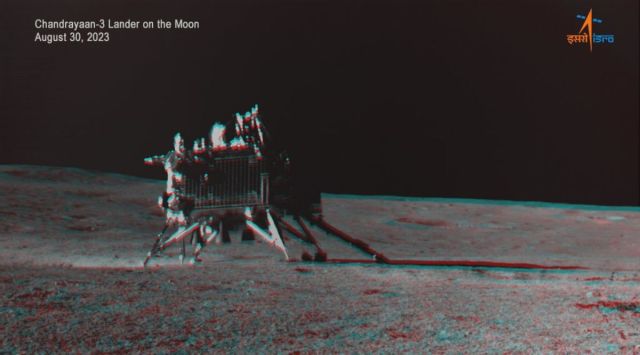ISRO shares 3D image of Chandrayaan-3’s Vikram lander taken by Pragyan rover
Check out this stereoscopic image of the Chandrayaan-3 mission's Vikram lander taken by the Pragyan rover.
 To view this image of the Chandrayaan-3 mission in 3D, you will need glasses with different coloured filters over each eye. (ISRO via X.com)
To view this image of the Chandrayaan-3 mission in 3D, you will need glasses with different coloured filters over each eye. (ISRO via X.com) Like a couple of close friends who have gone on vacation, the Indian Space Research Organisation’s (ISRO) Vikram lander and Pragyan rover, both of which are part of the Chandrayaan-3 mission, have been flooding the internet with images taken from the Moon. ISRO on Tuesday shared a 3D image of the lander taken by the rover.
The image shared by the space agency is an anaglyph. The word anaglyph usually refers to a stereoscopic photograph with two images superimposed and printed using different colours. When such an image is viewed with glasses with different colours for each eye, it can produce a sort of 3D effect.
Chandrayaan-3 Mission:
Anaglyph is a simple visualization of the object or terrain in three dimensions from stereo or multi-view images.
The Anaglyph presented here is created using NavCam Stereo Images, which consist of both a left and right image captured onboard the Pragyan… pic.twitter.com/T8ksnvrovA
— ISRO (@isro) September 5, 2023
In this case, the left image is in the red channel while the right image is placed in the blue and green channel, creating cyan. Essentially, if you use glasses with a red filter over the left eye and a cyan filter over the right eye, this image will look three-dimensional to you. This image was captured using the NavCam Stereo Imager on the Pragyan rover.
Chandrayaan-3 landed on the Moon on August 23. ISRO on September 3 said it put the lander and rover in hibernation mode as daylight time on the Moon was coming to an end. The mission was only expected to operate on the Moon for one lunar day which is approximately equivalent to about 14 days on our planet.
That is because the instruments on the rover and the lander are not designed to withstand very low temperatures. It can get as cold as minus 120 degrees Celsius during nighttime on the Moon. Just like lunar day, lunar night also lasts for nearly 14 days.
But there is still a chance that the electronics could survive the low temperatures of the lunar light. They might be able to power themselves up using the Sun’s energy when it rises up above the lunar horizon from the mission’s vantage point.
“We are going to start the process of making them (lander and the rover) sleep in the next couple of days so that they can withstand the night. Currently, the battery (on the rover) is fully charged. The solar panel is oriented to receive the light at the next sunrise expected on September 22, 2023. The receiver is kept on,” said ISRO chairman S Somnath while announcing that the rover and lander were placed in hibernation mode.






